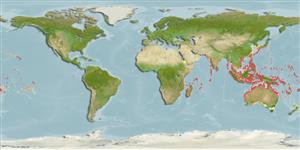Common names from other countries
Environment: milieu / climate zone / depth range / distribution range
Écologie
; profondeur 0 - 25 m (Ref. 349). Tropical; 36°N - 44°S, 32°E - 138°W
Indo-Pacific.
Length at first maturity / Taille / Poids / Âge
Maturity: Lm ? range ? - ? cm Max length : 32.0 cm SHL mâle / non sexé; (Ref. 101509); common length : 17.0 cm SHL mâle / non sexé; (Ref. 101509)
Shell length varies between 8.5 cm and 32 cm (Ref. 101509). Found in coarse sand with coral rubble and algae. Littoral to sublittoral, in tide pools and low tide level (Ref. 349). Inhabits seagrass beds (Ref. 98586).
Life cycle and mating behavior
Maturité | Reproduction | Frai | Œufs | Fécondité | Larves
Members of the order Neotaenioglossa are mostly gonochoric and broadcast spawners. Life cycle: Embryos develop into planktonic trocophore larvae and later into juvenile veligers before becoming fully grown adults.
Smith, B.D. 2003. (Ref. 3116)
Statut dans la liste rouge de l'IUCN (Ref. 130435)
statut CITES (Ref. 108899)
Not Evaluated
Not Evaluated
Menace pour l'homme
Harmless
Utilisations par l'homme
Pêcheries: commercial
| FishSource | Sea Around Us
Outils
Plus d'informations
Taille/ÂgeCroissanceLongueur-poidsLongueur-longueurMorphologieLarvesAbondance
Sources Internet
Estimates based on models
Preferred temperature
(Ref.
115969): 23.3 - 29.3, mean 28.3 (based on 3868 cells).
